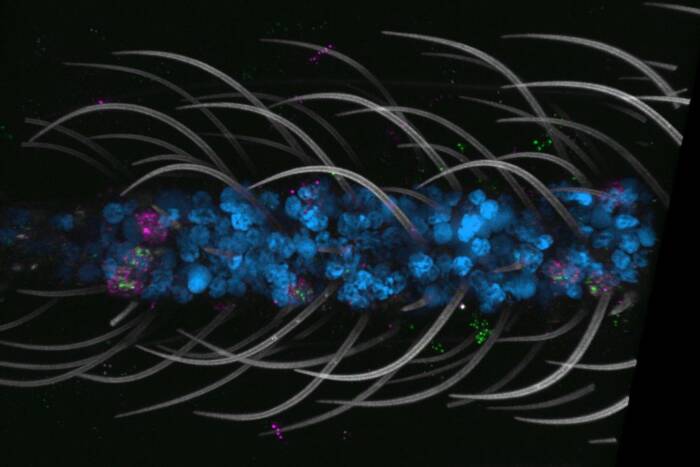Rockefeller’s redesigned website set to launch in March

The modernized rockefeller.edu features a responsive design that automatically optimizes each page to display at any width, on any device.
It has been more than a decade since Rockefeller’s most prominent public face received a major overhaul. That’s set to change next month, when the initial phase of a reimagined and redesigned rockefeller.edu launches. The new external site, which has taken two years to carefully plan and rebuild, features crisper messages, streamlined navigation, a responsive design that allows viewing across a range of devices, and significantly improved functionality—in other words, a website befitting Rockefeller’s stature as a leader in bioscience.
“A new, modern website is a crucial component of our communications strategy and is critical to reflecting who we are to the outside world,” says Timothy P. O’Connor, the university’s executive vice president. “The redesigned site not only beautifully represents the exceptional caliber of science that is done here, but it supports our interaction with prospective faculty, students, and donors, and clearly communicates our work and mission to external audiences.”
An in-depth audit
The redesign project began with an audit of the university’s communications efforts. In an initiative led by Franklin Hoke, executive director of Communications and Public Affairs, an external communications consulting firm identified ways the university could better connect with external groups and individuals who are important to its success. Using the results of this analysis, CPA developed a long-range strategic communications plan in 2015, with the need for a revamped website at the forefront.
Rockefeller’s website hasn’t been rebuilt since 2004, not counting occasional software and design updates. The communications audit identified a number of ways to make the site more useful for visitors—such as communicating Rockefeller’s mission in a clear and compelling way, and making sure the site’s structure is logical for users who know little about the university.
Researched and rebuilt
To support the redesign, CPA engaged two vendors—C&G Partners, a design firm, and DataArt, a technology consultancy—and hired a new assistant director of digital strategy, Meghan McCurdy, to oversee the project. The firms, in partnership with CPA and Information Technology, evaluated the site’s technical structure and content architecture. C&G’s digital team ran a comparative analysis of websites from peer institutions and assisted CPA in conducting dozens of stakeholder interviews with key groups on campus, including faculty, students, and administrative staff. They also helped to assemble groups of external users representing key audiences.
“This has been a meticulous, thoughtful process,” says Mr. Hoke. “At every step, we solicited vital input from a wide array of stakeholders, as well as from a CPA advisory committee that was asked to weigh in at critical points. We wanted to ensure that the new site would represent the entire university.”
The project’s technical development was equally complex and extensive. DataArt reviewed the existing site’s servers and backend systems. They combed through hundreds of pages and subdomains—many of which hadn’t been updated in years—to assess the existing framework. Starting from the ground up, they built a new software environment running on brand new hardware capable of handling a more demanding load. Over the months, as DataArt built the new content management and database systems, C&G developed the site’s navigational architecture and design templates.
The result is a robust and flexible platform that showcases modern, dynamic media such as videos and integrates with existing web-based systems, and which can easily be managed and expanded to accommodate the university’s evolving needs. The platform is a customized version of WordPress, a widely used open-source web platform under continual development, making it a logical choice that will allow rockefeller.edu to grow and change as the web itself does.
“What’s emerged is a site with stronger messaging, an enhanced visual identity, and a dramatically improved user experience,” says Ms. McCurdy. “The way information is organized has been streamlined and simplified, and staff members in charge of managing content will have robust new tools to do their jobs.”
“The discovery and design process produced a complete restructuring of the site’s content architecture as well as a refreshed look, which required our applications and web teams to implement a brand new technology stack using open-source software,” says Anthony Carvalloza, the university’s chief information officer. “The first phase of the website redesign project has completely modernized rockefeller.edu.”
Modern function and features
Among other improvements, the redesigned website features a new search engine, which will help users quickly find relevant content. The site’s desktop design was also developed in parallel with the mobile design, so when visitors pull up rockefeller.edu on their smartphones or tablets, they will access a mobile-optimized version of the whole site. The site will host a growing assortment of multimedia content, including new videos profiling the university’s lab heads. The videos—several will debut when the site launches, with more to come throughout the year—offer glimpses into the work, philosophy, and motivation of Rockefeller scientists.
Although the March launch represents the end of the redesign phase, it is in fact just the beginning of an ongoing effort to add, revise, and improve content and eventually absorb additional systems—such as the university intranet, InsideRockefeller, which was not part of this redesign—into the new architecture. CPA plans to work with labs and administrative groups across the university to help identify opportunities to enhance their specific pages. And CPA and IT will continue making incremental upgrades to increase functionality to the site in the coming months.
“The website is a living document,” says Ms. McCurdy. “We’ve only just completed the initial step.”


